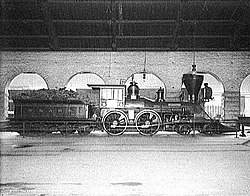W&A Subdivision

Map of the W&A, with locations of different events in the Great Locomotive Chase marked. The road did not extend beyond Atlanta and Chattanooga prior to its lease to the NC&StL.
|
|

One of the W&A's famous locomotives, The General, on display in the railroad's Union Depot in Chattanooga.
|
|
| Reporting mark | W&A |
|---|---|
| Locale | Tennessee, Georgia |
| Dates of operation | 1836–present |
| Successor | Nashville, Chattanooga and St. Louis Railway |
| Track gauge | 4 ft 8 1⁄2 in (1,435 mm) standard gauge |
| Previous gauge |
5 ft (1,524 mm) and 4 ft 9 in (1,448 mm) |
| Length | 138 miles (222 km) |
| Headquarters | Atlanta, Georgia |
The Western & Atlantic Railroad of the State of Georgia (W&A) is a historic, government-owned railroad which operates in the southeastern United States from Atlanta, Georgia to Chattanooga, Tennessee.
It was founded on December 21, 1836. The city of Atlanta was founded as the terminus of the W&A, with the terminus marked with the Atlanta Zero Mile Post. The line is still owned by the State of Georgia from Atlanta to CT Tower in Chattanooga; it is leased by CSX Transportation.
The W&A Subdivision is a railroad line leased by CSX Transportation in the U.S. states of Tennessee & Georgia. The line runs from Chattanooga, TN to Marietta, GA for a total of 119.1 miles. At its north end it continues south from the Chattanooga Subdivision of the Nashville Division and at its south end it continues south as the Atlanta Terminal Subdivision (Chart A).
This line, originally built to 5 ft (1,524 mm) gauge, is famous because of the Andrews Raid (commonly referred to as the Great Locomotive Chase), which took place on the W&A during the American Civil War on the morning of April 12, 1862.
In 1836, the Georgia General Assembly voted to build the Western & Atlantic Railroad of the State of Georgia to provide a link between the port of Savannah and the Midwest. The initial route of that state-sponsored project was to run from Chattanooga to a spot east of the Chattahoochee River, in present-day Fulton County. The plan was to eventually link up with the Georgia Railroad from Augusta and the Macon and Western Railroad, which ran from Macon to Savannah. An engineer was chosen to recommend the location where the Western & Atlantic line would terminate. Once he surveyed various possible routes, he drove a stake into the ground near what is now Forsyth and Magnolia Streets. The zero milepost was later placed at that spot. In 1842, the zero milepost was moved to a spot immediately adjacent to the current day southern entrance to Underground Atlanta. The area developed into a settlement, known as "Terminus", literally meaning "end of the line". In 1843, the small settlement of Terminus was incorporated as the city of Marthasville. Two years later, by Act of the Georgia General Assembly the city was renamed "Atlanta".
...
Wikipedia
